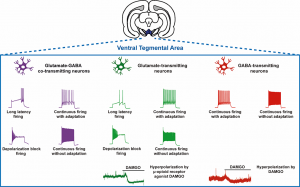Featured Paper of the Month – August 2021
 Published in European Journal of Neuroscience by Jorge Miranda-Barrientos and Marisela Morales, et al. in the NIDA IRP Neuronal Networks Section.
Published in European Journal of Neuroscience by Jorge Miranda-Barrientos and Marisela Morales, et al. in the NIDA IRP Neuronal Networks Section.
Summary
The ventral tegmental area (VTA) contains dopamine neurons intermixed with GABA-releasing (expressing vesicular GABA transporter, VGaT), glutamate-releasing (expressing vesicular glutamate transporter 2, VGluT2), and glutamate-GABA co-releasing (co-expressing VGluT2 and VGaT) neurons. By delivering INTRSECT viral vectors into the VTA of double vglut2-Cre/vgat-Flp transgenic mice, we targeted specific VTA cell populations for ex vivo recordings. We found that VGluT2+ VGaT- and VGluT2+ VGaT+ neurons on average had relatively hyperpolarized resting membrane potential, greater rheobase, and lower spontaneous firing frequency compared to VGluT2- VGaT+ neurons, suggesting that VTA glutamate-releasing and glutamate-GABA co-releasing neurons require stronger excitatory drive to fire than GABA-releasing neurons. In addition, we detected expression of Oprm1mRNA (encoding µ opioid receptors, MOR) in VGluT2+ VGaT- and VGluT2- VGaT+ neurons, and that the MOR agonist DAMGO hyperpolarized neurons with these phenotypes. Collectively, we demonstrate the utility of the double transgenic mouse to access VTA glutamate, glutamate-GABA, and GABA neurons to determine their electrophysiological properties. SIGNIFICANT STATEMENT: Some physiological properties of VTA glutamate-releasing and glutamate-GABA co-releasing neurons are distinct from those of VTA GABA-releasing neurons. µ-opioid receptor activation hyperpolarizes some VTA glutamate-releasing and some GABA-releasing neurons.
Publication Information
In: European Journal of Neuroscience, vol. 54, no. 1, pp. 4061-4084, 2021.
